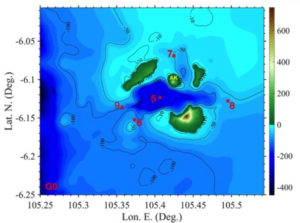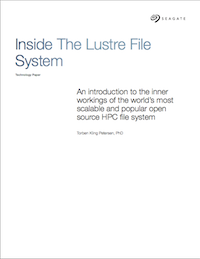
A supercomputer-generated model of the tsunami from the December 22, 2018 lateral collapse of the Anak Krakatau volcano in the Sunda Straits, Indonesia. Multiple simulations were run at the same time on SDSC’s Comet supercomputer so researchers could consider different scenarios. Image Credit: S. Grilli, et al.
Researchers at the University of Rhode Island are using XSEDE supercomputer to show that high-performance computer modeling can accurately simulate tsunamis from volcanic events. Such models could lead to early-warning systems that could save lives and help minimize catastrophic property damage.
URI Distinguished Professor and Chair of the Department of Ocean Engineering Stephan Grilli and his team recently published research results in the Nature Scientific Reports. Their paper focused on the December 22, 2018, collapse of the Anak Krakatau volcano and subsequent tsunami, which was the first time in recent history an event such as this happened. The event allowed researchers an opportunity to test their models and modeling methodologies for accuracy against the observations that were recorded.
The URI scientists created their simulations while working with British Geological Survey collaborators, who surveyed the Indonesian area several times in 2019, where more than 400 people were killed during the late 2018 event. The URI models were completed using Comet and successfully reproduced post-tsunami characteristics, tide gauge records, and eyewitness reports – suggesting that their landslide volume range and assumed collapse scenarios were accurate.
As part of this project, we performed simulations on Comet that considered different volcanic collapse volumes, and it saved us a lot of time being able to model all of those scenarios concurrently on a supercomputer,” explained Lauren Schambach, a URI doctoral student. “As our understanding of the complex physics related to tsunamis grows, access to XSEDE supercomputers such as Comet allows us to improve our models to reflect that, whereas if we did not have access, the amount of time it would take to such run simulations would be prohibitive.”
We are hopeful that our continued research reduces warning systems from several hours to approximately ten minutes so that more people can reach safety prior to a tsunami. — Stephan Grilli, URI Distinguished Professor and Chair of the Department of Ocean Engineering
Ultimately, their supercomputer simulations demonstrated that, in cases such as Anak Krakatau, the absence of precursory warning signals, together with the short travel time following tsunami initiation, presents a major challenge for mitigating tsunami coastal impact.
However, Grilli said “we are hopeful that our continued research reduces warning systems from several hours to approximately ten minutes so that more people can reach safety prior to a tsunami.”
In another, related study, Schambach and Grilli worked with researchers at the University of Delaware using XSEDE-allocated resources to simulate an infamous East Coast landslide that happened approximately 16,000 years ago. The work is important because, though the U.S. eastern seaboard is at a lower risk of tsunami than the Pacific Rim, historical waves have caused damage in the region and it would be useful to know how severe the damage would be should a tsunami like the one 16,000 years ago recurs. For this work, they partnered with the National Oceanic and Atmospheric Administration’s National Tsunami Hazard Mitigation Program (NTHMP).
The team’s initial goal was to test the worst-case scenarios of the undersea landslide that triggered the prehistoric tsunami. To do this, they needed to vary the conditions of the landslide, and to consider different locations off the East Coast. The calculations would have taken far too much time if carried out one after another. The power and number of general-purpose nodes on Bridges at the Pittsburgh Supercomputing Center and Comet allowed them to test different scenarios at the same time. In addition, Bridges’ mammoth parallel data storage system allowed them to store their data while still being able to retrieve it rapidly.
The scientists’ simulations provided largely expected results, though researchers had not previously known the extent to which the different conditions would affect the resulting tsunamis. “Rigid slump” landslides, in which the sea bottom breaks off more or less as one piece, caused 50 percent more damage than “deforming slides,” which crumble as they move. Not surprisingly, landslides off heavily populated regions such as the Jersey Shore or Ocean City in Maryland could do a lot of damage.
Access to XSEDE supercomputers allows us to quickly run many simulations on these types of projects, Further, these XSEDE resources enable us to create detailed models that would otherwise be impossible. — Lauren Schambach, URI doctoral student
An important variable was the roughness of the sea floor—sandy ocean beds led to less friction and more powerful waves; more common gravely bottoms tended to disperse the wave and cause less impact on the coast. Including such dispersion proved important, because dispersion caused short waves that travel with the main tsunami. The dispersion caused the second wave to hit the shore to be the most powerful, not the first. Also, the waves that followed the second wave were stronger than in the dispersion-free simulation.
The team reported their results in the journal Pure and Applied Geophysics in July 2019.
Access to XSEDE supercomputers allow us to quickly run many simulations on these types of projects,” said Schambach. “Further, these XSEDE resources enable us to create detailed models that would otherwise be impossible.”
Source: Dave Lavallee (University of Rhode Island), Ken Chiacchia (Pittsburgh Supercomputing Center), and Kimberly Mann Bruch (San Diego Supercomputer Center, UC San Diego) via XSEDE
Sign up for our insideHPC Newsletter




